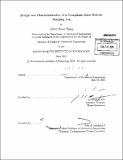Design and characterization of a compliant-joint robotic jumping leg
Author(s)
Wang, Albert Duan
DownloadFull printable version (2.387Mb)
Alternative title
Compliant-joint robotic jumping leg
Other Contributors
Massachusetts Institute of Technology. Dept. of Mechanical Engineering.
Advisor
Sangbae Kim.
Terms of use
Metadata
Show full item recordAbstract
Biological systems employ compliant joints to allow robust contact with the surroundings and to increase locomotive efficiency. In this experiment, we designed a three-link robotic leg with a compliant calf tendon that was acutated by a DC motor at the hip and measured the effect of compliance on the force profile and energy consumption for a single jump. The lengths of the femur, tibia, and foot were 150 mm, 210 mm, and 60 mm respectively. Overall vertical leg stiffness was varied from 472 N/m to 3980 N/m. Using a 40 degree angle ramp for the motor acutation profile, adding compliance tended to distribute force over time at a smaller magnitude which resulted in longer contact time with the ground. Total impulse was found to vary and peaked at a value of 3.42 Ns for a overall leg stiffness of 1180 N/m. The findings suggest that these systems can be optimized for performance by tuning the stiffness of compliant joints.
Description
Thesis (S.B.)--Massachusetts Institute of Technology, Dept. of Mechanical Engineering, 2010. Cataloged from PDF version of thesis.
Date issued
2010Department
Massachusetts Institute of Technology. Department of Mechanical EngineeringPublisher
Massachusetts Institute of Technology
Keywords
Mechanical Engineering.